They say… 
Best beer and travel writing award 2015, 2011 -- British Guild of Beer Writers Awards
Accredited Beer Sommelier
Writer of "Probably the best book about beer in London" - Londonist
"A necessity if you're a beer geek travelling to London town" - Beer Advocate
"A joy to read" - Roger Protz
"Very authoritative" - Tim Webb.
"One of the top beer writers in the UK" - Mark Dredge.
"A beer guru" - Popbitch.

|
Ридна марка Пшеничне Еталон
First published in BEER November 2006 as part of a piece about beers stocked by Tesco supermarkets. See previous post for more Tesco beers.
ABV: 5 per cent
Origin: Radomyshl, Zhytomyr Oblast, Ukraine
Website: www.etalon-beer.com.ua
 Ridna Marka Pshenychne Etalon In 2005 the Beer Challenge added a category for imported beers and the first winner was a genuine, and rather pleasing, surprise – a Bavarian-style unfiltered wheat beer from, of all places, Ukraine. It’s still a regular line in larger Tesco stores, having long outlived its original guaranteed listing.
The brewery at Radomyshl, about 70km outside Kiev, was established by Czechs in 1886 but was only offering an undistinguished blond lager when bought by fruit juice company Ridna Marka in 2003.
The new bosses had enjoyed wheat beers in Munich, and took the brave decision to turn their acquisition into a state of the art weissbier facility, bringing in experts from the Doemens brewing academy in Gräfelfing and an un-named Bavarian brewery, rumoured to be Erdinger.
Following local success, in 2004 the beer caused an international stir by beating several leading German Weissbier brands at the World Beer Cup and the Brewing Industry International Awards.
It pours a lightly cloudy golden with a good white head and a restrained slightly salty wheat aroma with typical banana tones and snatches of hops and coal dust.
The palate is creamy and fruity enough to remind you of fresh banana sliced into custard, lifted by a wash of citrus. The mouth feel is a little thin textured but not overly carbonated, with plenty of flavour.
A slight saltiness with brackish hops leads to a grainy, chewy finish with herbal notes and a final burst of banana.
While international judges might have gone too far in putting this beer ahead of the likes of Schneider, it’s still an impressively confident and tasty interpretation of the style that certainly gives Erdinger, its most obvious model, a run for its money.
Read more reviews of Tesco beers in the next post.
Read more about this beer at ratebeer.com: http://www.ratebeer.com/beer/pshenychne-etalon/44746/
First published in BEER November 2006 as part of a piece about beers stocked by Tesco supermarkets.
NOTE: Production of Young’s beers has since been moved to Wells & Young’s in Bedford, though it appears Ruby Star is no longer brewed.
ABV: 5.5 per cent
Origin: Wandsworth, London, England
Website: www.youngs.co.uk
 Young's Ruby Star Tesco is truly a giant among retailers. With almost a third of the UK market, the supermarket chain is easily Britain’s biggest, and people are now talking about its influence on the high street as “tescopoly”. So given the importance of supermarkets in beer retailing, how does the market leader’s beer offer measure up?
The answer is a mixed one. While some of nearly 2,000 stores devote up to 10 metres of aisle to speciality ales, the proportion of filtered lines from “usual suspects” is arguably higher than in other chains. But at the same time Tesco remains the only chain to host its own major beer award.
Formerly known as the Tesco Beer Challenge, now the Drinks Awards, the scheme has a proud record of introducing tasty new beers to the public.
The contest is discussed elsewhere in this month’s Beer, so here I’ve taken the opportunity to review three beers currently in Tesco, starting with this year’s Autumn/Winter Best Beer in the “large brewer” category, Young’s Ruby Star.
Though the label carries the Wells & Youngs Bedford address, this bottle conditioned red ale was one of the last beers from the brewery’s historic Wandsworth site.
It’s an unusual beer that’s essentially a very rich-flavoured, strong and slightly light-coloured dry brown ale. The colour is actually a delightful reddish amber, and my bottle was easy to pour crystal clear with a good sparkle and a bubbly persistent yellowish head.
There’s a creamy malt and mineral aroma with juicy berry notes just detectable, leading to more berries in a full, sappy, nicely sparkling palate with good malt and firm, slightly biting hop dryness from the start, and austere hops and generous fruit juice in superb balance.
A long finish starts off dry and gets dryer, with a hint of coffee roast, and powerful, slightly astringent peppery hop bitterness developing towards the end.
Young’s needs no introduction to What’s Brewing readers, especially since the brewery has been in the news first with its controversial decision to close its historic southwest London site and move production in with Wells at Bedford, then with the sad death of chairman and real ale champion John Young.
But the launch of a fine award-winning new bottled beer at least provides a swan song for the Ram brewery – and an excellent example of John Young’s legacy in its fine balance of innovation and traditional quality.
Read more reviews of Tesco beers in the next post.
Read more about this beer at ratebeer.com: http://www.ratebeer.com/beer/youngs-ruby-star/66281/
First published in BEER October 2006 as part of a page marking the publication of the latest Good Bottled Beer Guide. For more beers featured on this page, see previous post.
ABV: 4.7 and 5.5 per cent
Origin: Thorpe St Andrew, Norfolk, England
Website: www.thewhynotbrewery.co.uk
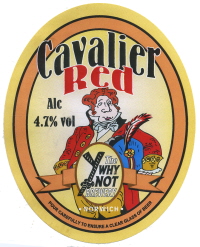 Why Not Cavalier Red Eastern England is becoming Britain’s beer heaven and Norfolk in particular boasts a long and impressive list of craft brewers. The tiny Why Not brewery (as in “Fancy a beer? Why not?!”), run by former hobby brewer Colin Emms from a shed behind his house near Norwich, joined the list in 2005 and is already holding its own among some very distinguished company.
The brewery boasts of the local provenance of its barley, grown at Branthill Farm, Wells-Next-the-Sea and malted by Crisps of Fakenham. All three current beers also feature English Fuggles and Goldings hops.
Colin is one of the few British brewers who started with Real Ale in a Bottle then branched out to cask. All the beers are well-made to distinctive original recipes, but the two featured here are the ones I found most interesting.
Cavalier Red is an unusual bitter with a ruddy twist created by judicious use of crystal and chocolate malts alongside Maris Otter pale, pouring a dark reddish amber with a little off-white head.
An inviting nutty aroma has a hint of stewed gooseberries alongside spicy roast notes, leading to a generously nutty, sappy, lightly roasted malt palate, lightly carbonated with drying but restrained herby hops. Lemon barley notes emerge in a drying and bitterish but still juicy finish.
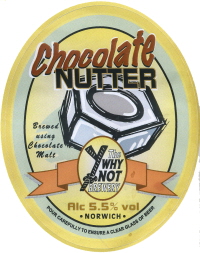 Why Not Chocolate Nutter Chocolate Nutter has a similar recipe but ups the proportion of chocolate malt to produce a very dark dry brown ale, once again with a reddish tinge, and a bubbly fawn head.
A coffee and baked vine fruit aroma sets up a chewy, very malty and slightly sweetish palate with fruit cake and chocolate notes, but light bodied and refreshing considering the colour and strength. Well-balanced burry dryness and leafy bitterness emerge and develop in a slightly smoky finish over rich malt character.
Read more about these beers at ratebeer.com:
http://www.ratebeer.com/beer/why-not-cavalier-red/59599/
http://www.ratebeer.com/beer/why-not-chocolate-nutter/63109/
First published in BEER October 2006 as part of a page marking the publication of the latest Good Bottled Beer Guide. For more beers featured on this page, see previous post.
Jaipur was also featured in BEER August 2008 as part of a piece about beers for summer outdoor drinking and in the Beer Sellers piece on Westholme Store.
Note: Kelly Ryan, who earned his brewing reputation at Thornbridge brewer before returning to his native New Zealand to work at Epic, tells me he was encouraged to apply for the Thornbridge job partly by reading this piece.
ABV: 5.9 and 7.7 per cent
Origin: Ashford-in-the-Water, Derbyshire, England
Website: www.thornbridgebrewery.co.uk
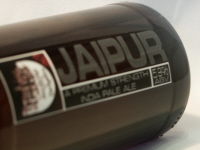 Thornbridge Jaipur Over the past month I’ve been privileged to sample more beers from breweries featured for the first time in the new edition of the Good Bottled Beer Guide, discussed last issue. And among those making a big impression are a brace of modern interpretations of classic styles from a country house brewery in the Peak District national park.
Thornbridge Hall is a stately home just outside Bakewell with a history dating back to the 12th century. Still privately owned, it’s now a venue for events as well as a family home.
A brewery opened on site in 2004 and already boasts a string of awards from CAMRA and SIBA for its cask beers. Real Ale in a Bottle first appeared in 2005 with forays into two historic styles, India Pale Ale (IPA) and Imperial Russian Stout.
Both styles originate in late 18th century London, but their development was shaped by the export trade. Virtually extinct in their home country by the late 20th century, their recent revival has been driven at least as much by international as by domestic interest.
Given this international pedigree, it’s appropriate that a Scot and an Italian, Martin Dickie and Stefano Cossi, are the brewers behind the Thornbridge versions.
Jaipur IPA is named after the famous pink stucco city in Rajasthan, northern India, and brewed with pure Maris Otter pale malt for an authentic rich golden colour.
There’s a further international flourish in the use of American Chinook and Cascade hops. The generous hopping of IPA was originally to help preserve it during its long sea voyage, but it was this feature that endeared the style to hop-loving US craft beer fans, with the result that strong, well-hopped IPA is now much more common on the other side of the Atlantic.
“Can be enjoyed cloudy”, says the label – a good job since my sample proved impossible to pour clear. The beer emerges hazy and golden, topped with a rocky white head, yielding a strong resiny and chaffy aroma, with notes of dried apricots, sulphur and spiced orange.
The palate starts with rich, sweetish malt but nettly hop resins bite almost immediately, spicy but not yet bitter and rich with blackcurrant and apricot nectar flavours.
A burry swallow leads to a dry finish with more fruit traces, then a complex, puckering peppery bitterness becoming very pronounced and sustained. Although a touch too low in gravity for the style, this tasty beer is likely to mature in the bottle for a year or so: indeed the label boasts a space for a “best after” date, not filled in on my sample.
 Thornbridge Saint Petersburg Also borrowing its name from one of the world’s more architecturally impressive cities is Saint Petersburg Imperial Russian Stout, in another once near-extinct style now undergoing a revival of interest.
The name Saint Petersburg isn’t just an arbitrary Russian reference: a former owner of the Hall made his dosh selling Manchester textiles through the eponymous Baltic port. As with the IPA, the Derbyshire version is on the low gravity side for a style that can easily chalk up 10 per cent ABV or more, but it’s still packed with flavour.
Brewed from pale and chocolate malts, roasted barley and Galena and Bramling Cross hops, the beer emerges a shade of ruby so dark it’s almost black, with a rich, thick fawn-coloured head.
The roasty, creamy aroma has blackcurrant and leather notes but an attractive and surprisingly light freshness, leading to more roast and blackcurrant with strawberry and pear drop esters on the palate, along with cola, gravy, chocolate and a whiff of smoke.
The big dry finish boasts more dark malt and roast with emerging spicy hops and a complex fruity, liquoricey development, with enough alcohol to add a warming note.
The beer has already earned itself a well-deserved star in the Good Bottled Beer Guide and I’d rate it alongside interpretations from Harveys and Meantime as the leading British-brewed examples of this threatened style.
Read about more beers featured in the 2006 Good Bottled Beer Guide in the next post.
Read more about these beers at ratebeer.com:
http://www.ratebeer.com/beer/thornbridge-jaipur/48795/
http://www.ratebeer.com/beer/thornbridge-st-petersburg/55938/
First published in BEER September 2006 as part of a page marking the publication of the latest Good Bottled Beer Guide. For more beers featured on this page, see previous post.
ABV: 4.2 per cent
Origin: Horsham, Sussex, England
Website www.suthwykales.com
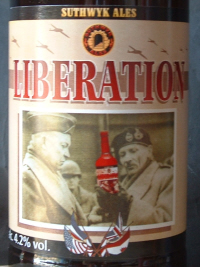 Hepworth Suthwyk Liberation Contract brewing is sometimes viewed with suspicion, but if it’s honestly done there are many advantages for the would-be bottler, not least of which is finding a well-equipped and experienced contractor who can be relied upon to ensure your brands are bottled at their best. And they don’t come much more reliable than Hepworth & Co, the discreet collaborator in several excellent brands marketed by others.
Hepworth customer Suthwyk Ales may not actually brew the beer bearing its name but still has a special claim to its provenance – the Optic barley used in the grist is grown at its own farm on Portsdown Hill, Southwick (“Suthwyk” is the local pronunciation), overlooking Portsmouth Harbour.
Liberation, another GBBG starred beer, earns its name partly from its status as a single hop brew containing only US Liberty hops, but also nods to Eisenhower and Montgomery, who planned the D-Day landings from nearby Southwick House. Thanks to the wonders of Photoshop, they’re depicted on the label inspecting a Suthwyk bottle.
The beer itself is a rich warm golden with a sparse, sticky sediment, a good white head and a fragrant, slightly sweetish pineapple aroma. The smooth, clean, dry palate has a subtle blackcurrant leaf note and a drying bite of hops.
There’s more blackcurrant in a light, refreshing finish that turns quite bitter and peppery, though staying supremely quaffable. An international compliment in the best possible taste.
For more beers featured in the Good Bottled Beer Guide 2006 see next post.
Read more about this beer at ratebeer.com: http://www.ratebeer.com/beer/suthwyk-liberation/38409/
First published in BEER September 2006 as part of a page marking the publication of the latest Good Bottled Beer Guide. For more beers featured on this page, see previous post.
ABV: 5 per cent
Origin: Bowburn, Durham, England
Website: www.durham-brewery.co.uk
 Durham Evensong A particularly welcome (and, in my view, long overdue) innovation in the latest GBBG is a simple system for highlighting quality. Rosettes indicate breweries producing Real Ale in a Bottle to a consistently high standard, while a select few outstanding individual beers earn a star.
Bottle conditioning is a tricky business, and it has to be admitted that not all small British brewers offering RAIB have quite got the hang of it yet. Let’s hope the GBBG awards become the coveted Michelin stars of British bottled beer, encouraging brewers to the pursuit of excellence.
One entrant boasting not only a well-deserved rosette but a constellation of stars is the Durham Brewery of Bowburn, a former mining village just to the south of Durham city. This multi-award-winning micro, founded in 1994, excels in both cask and bottle with tasty and imaginative brews.
The label designs on the bottled beers might reference the ancient ecclesiastical heritage of the region, but the beers combine contemporary styles and techniques with inspiration from the more recent past.
Star beer Evensong, CAMRA’s Champion Bottled Beer of Britain in 1995, is based on a 1937 recipe from Whitakers of Halifax, closed by Whitbread in 1969. Maris Otter pale, crystal, amber and Munich malts, wheat malt, Goldings, Fuggles and Challenger hops combine to create a speciality with elements of both old ale and strong bitter.
The result is a rich burgundy with a creamy yellowish head, lots of lace and a toasty fruit cookie aroma with a note of dry cooking apples. The sappy palate has rich malt, autumn fruits and hints of dark marmalade but remains light and refreshing.
There’s a salty mineral tang to the finish, with more orchard fruit and faint roast, finally turning dry with twiggy hop notes. Well worth seeking out, and particularly recommended to drinkers of lighter beers that haven’t yet discovered the delights of the dark side.
Read about more beers featured in the 2006 Good Bottled Beer Guide in the next post.
Read more about this beer at ratebeer.com: http://www.ratebeer.com/beer/durham-evensong/23346/
First published in BEER September 2006 as part of a page marking the publication of the latest Good Bottled Beer Guide.
ABV: 5.2 and 6 per cent
Origin: Wrexham, Denbighshire, Wales
Website: www.jollybrewer.co.uk
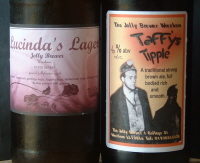 Jolly Brewer Lucinda's Lager and Taffy's Tipple This year’s Great British Beer Festival saw the launch of the the sixth edition of Jeff Evans’ Good Bottled Beer Guide, a book that’s become as indispensable to beer enthusiasts as its big brother the Good Beer Guide, not only providing a snapshot of an increasingly large and confident industry but itself acting as an inspiration to further growth.
Each edition has been reassuringly fatter than its predecessor and the latest has the dimensions of a respectable novel rather than a slim volume, its extra pages packed with new entrants. Among them is the Jolly Brewer of Wrexham, a welcome addition to the small group of Welsh brewers listed.
The Brewer is in fact a long-established home brew supplies and specialist beer shop run by Penelope “Pene” Coles, who expanded into brewing back in 2000. The beers are filled by hand into elegant continental style bottles, and even the ABV is handwritten on the attractive labels, acknowledging that each mash is different.
Having just returned from Germany where I’d enjoyed several craft-brewed unfiltered lagers, I was especially intrigued by Lucinda’s Lager, brewed with Pilsener malt and proper cold-fermenting yeast, hopped with Goldings, Fuggles and Hallertau and stored for “longer than usual” before being released.
It pours a pale, slightly hazy yellow-gold with a good white head, the rich zesty floral orange aroma tinted by the honeyed notes often found in unpasteurised pale lager. But the palate has more of an Anglo-American intensity, with resiny hops from the start over crisp but slightly syrupy malt.
A flash of bitter orange on the swallow leads to a long leafy, peppery hop finish with a touch of ginger. Overall this is a big, dry beer that still remains crisp and refreshing.
In a contrasting shade, but exhibiting the same love of hops, is strong dry brown ale Taffy’s Tipple. This is a rich dark amber-brown beer with a thick creamy yellow head, and a slightly smoky dark malt and straw aroma.
The full palate with its tangy cola and blackcurrant notes is soon leeched dry by assertive burry hops. Hints of brown sugar soften complex hops and tart plum skins on the finish.
Chocolate and amber malts add colour to Maris Otter pale in the recipe, and that big hop bite comes courtesy of Target, Goldings, Challenger and a dose of Northern Brewer at the end of the boil. A fine brew from a brewery to watch.
Read about more beers featured in the 2006 Good Bottled Beer Guide in the next post.
Read more about these beers at ratebeer.com:
http://www.ratebeer.com/beer/jolly-brewer-lucindas-lager/108042/
http://www.ratebeer.com/beer/jolly-brewer-taffys-tipple/86453/
First published in BEER August 2006
 Great British Beer Festival 2006 The Great British Beer Festival is sometimes known as the biggest pub in the world, but for the dedicated beer hunter it’s also one of the best offies in the world as well. You’d be hard put to find anywhere else that offers such an imaginative and eclectic international mix of classics and rarities in convenient portable form.
Although the imported beers at the Bières sans Frontières bars are an attraction in themselves, British bottled beers have long had a presence too and in recent years the choice has widened and deepened, following both the growth in the market and CAMRA’s increasing committment.
This year I’ve been privileged to get an advanced peek at the RAIB bar beer list, which excited me so much I’ve decided to suspend this column’s usual focus on just three beers. From around 75 different lines on order, I’ve picked a dozen — not necessarily “the best” but a selection that captures the richness and diversity of live bottled beers currently on offer from British brewers.
I should qualify “British” because, with the exception of one beer each from Scotland and Wales (neither of which I’ve found room for here), this year’s list is entirely from England. While regrettable, this fact is more of a reflection on the curious rarity of bottle conditioning in the other countries of the UK than, I think, the chauvinism of the buyers.
The selection runs the gamut of British beer styles, including four welcome examples of that still relatively rare beast, the bottle conditioned mild. Of these Banks & Taylor Black Dragon Mild (4.3 per cent ABV), from Shefford, Bedfordshire, is an excellent interpretation of the style, with a light and refreshing but generously malty palate, slightly sourish fruit and herbal flavours, finishing with fruit, malt and a moreish roasty edge.
There’s a strong choice of bitters including from the likes of RCH and Woodfordes, but I’d plump for Hogs Back BSA (4.5 per cent), recently praised in this column for its rich malt, wet stone notes and citrus aroma, biscuity palate, and leafy hop finish with a good dose of peppery bitterness. It comes from an exemplary farmhouse micro in Tongham, Surrey.
The list reflects the growing popularity of blond and golden ales, including a gluten-free choice, and, given the season, I’ve allowed for a couple of these. Oakleaf Hole Hearted (4.7 per cent), from an award-winning Gosport, Hampshire-based micro, is an American-inspired single hop beer featuring the floral, fruity notes of Cascade over a relatively full-bodied cereal palate.
Also targeting summer thirsts is Wychwood Duchy Originals Summer Ale (4.7 per cent), another beer with a hoppy accent, this time from Belgian-grown Fuggles and Goldings and English Target. Originally commissioned by Waitrose supermarkets and hard to find otherwise, this is the only bottle conditioned beer in the Duchy Originals range of organic products (proprietor HRH The Prince of Wales), supplied from Witney, Oxfordshire.
Wheat beers include O’Hanlons Double Champion [since renamed Goldblade] (4 per cent), one of several offerings on the list from this excellent micro in Clyst St Lawrence, Devon. Spiced with coriander and late-hopped with First Gold and Cascade, this subtle beer has a touch of Turkish delight in the aroma and is dry and clean, with banana, vanilla and citric tones.
Stepping up the strength, the list includes five interpretations of Britain’s hoppiest traditional style, India Pale Ale, including arguably the best revivalist example available, Burton Bridge Empire Pale Ale (7.5 per cent), from IPA’s spiritual homeland of Burton-on-Trent, Staffordshire. This impressive beer has ozone and orange zest on the aroma and assertive vegetal hops on a rich complex palate with peach notes on a very long finish.
Newly-launched Cornish interpretation St Austell Proper Job (5.5 per cent) is at a more approachable though less authentic strength for a true IPA, but is packed with flavour including roses, honey, pineapple, strawberries, lime and pepper – the chewy hop finish never overpowers.
Several other pale ale variants inspired by old recipes can be found on the list: Fullers 1845 and White Shield, surely two of the best British bottled beers around, are hard to pass over but widely available elsewhere. Spare some space, though, for Youngs Special London Ale (6.4 per cent), a big nutty, malty and figgy ale made with “phenomenal amounts” of Fuggles and Goldings hops – this will be some of the last made in London, before production moves to Bedford.
In a darker mood, the selection of porters and stouts includes several established RAIB classics, notably RCH Old Slug Porter (4.5 per cent) and Wye Valley Dorothy Goodbody’s Wholesome Stout (4.6 per cent). The former, from Weston-super-Mare, Somerset, belies its unappetising name with a tempting liquorice and vanilla pastille aroma and nutty herbal coffee and burnt fruit flavours with a hint of sage.
The latter, from Stoke Lacy, Herefordshire, is inspired by dry Irish stout but knocks the spots off the best-known commercial examples of the style. It’s much tastier than it deserves to be at this strength, with smooth malted milk, fruity acidity, leather and a long roasty finish with a hint of cinnamon.
Several notches of gravity upwards are a trio of Imperial stouts, including current benchmark interpretation Harveys Imperial Extra Double Stout (9 per cent), from Lewes, Sussex. This masterfully complex and marvellously cakey, oily brew, redolent of fennel seeds and mocha, will develop for many years in the bottle.
For a final bottle to cellar away for bedtime sipping in years to come, there’s a choice of three barley wines. I’d pick Woodforde’s Headcracker (7 per cent) – light of both alcohol and heart for the style, with fecund hops, orange marmalade and fluffy fruit salad in the finish. The brewery, in Woodbastwick, Norfolk, is something of an RAIB specialist, with several excellent examples of the heights bottled beer can reach in talented and sympathetic hands.
It’s understandable if in the past you’ve just stuck to the enormous choice of draught beers at GBBF, but there couldn’t be a better time to stretch the benefits of admission by joining the carry out club. By the way, you can spot us by our suspiciously clanking rucksacks.
Great British Beer Festival Real Ale in a Bottle Bar 2006
ABV: 4.5%
Origin: Weston-super-Mare, Somerset, England
Website: www.rchbrewery.com
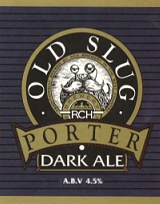 RCH Old Slug Porter Dark Ale RCH, a veteran among British micros of bottle conditioned ales, originated behind the Royal Clarence Hotel at Burnham-on-Sea in 1983, thus its acronymic title, but moved to a former cider mill in Weston a decade later and significantly expanded at the turn of the millennium.
Old Slug porter, named after the shell-less molluscs that infested the hotel garden, might sound unappetising but is justly celebrated and multi-award-winning as one of the earliest revivalist porters still in production. There’s a grist of pale, crystal and black barley malts, with traditional Fuggles and Goldings hops.
It’s very dark, with a rich cream head and a burnt pastilley liquorice and vanilla aroma. A bubbly palate has nutty coffee and liquorice, with slightly herbal burnt fruit, firmly dry with developing hoppy bitterness. There’s dark malt and coffee notes in the finish with some burnt vine fruit, tangy plum and sage flavours.
Read more about this beer at ratebeer.com: http://www.ratebeer.com/beer/rch-old-slug-porter/5846/
Great British Beer Festival Real Ale in a Bottle Bar 2006
ABV: 5.5%
Origin: St Austell, Cornwall, England
Website: www.staustellbrewery.co.uk
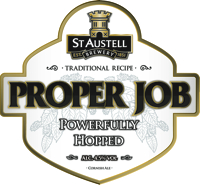 St Austell Proper Job This Cornish interpretation of an old-fashioned IPA is a little light in alcohol to be true to the style, but very approachable and tasty. Dedicated to the 32nd (Cornwall) Regiment, who fought in Indian Mutiny, it’s made from Cornish-grown Maris Otter pale barley malt and three North American hop varieties: Willamette, Cascade and Chinook.
It’s a bright golden with a soft foamy white head and a resiny fruit salad, rose and honey aroma. The palate is crisp and fruity, its light malt laced with strawberrry, pineapple and lime, tangy on the tongue and with flinty background flavours and peppery hops emerging. A soft swallow leads to a strawberry finish with grainy malt underlying the emergence of big chewy hops that never quite overpower the beer.
Read more about this beer at ratebeer.com: http://www.ratebeer.com/beer/st-austell-proper-job-bottle/59023/
|
Cask  This pioneering new book explains what makes cask beer so special, and explores its past, present and future. Order now from CAMRA Books. Read more here. This pioneering new book explains what makes cask beer so special, and explores its past, present and future. Order now from CAMRA Books. Read more here.
London’s Best Beer  The fully updated 3rd edition of my essential award-winning guide to London’s vibrant beer scene is available now from CAMRA Books. Read more here. The fully updated 3rd edition of my essential award-winning guide to London’s vibrant beer scene is available now from CAMRA Books. Read more here.
|
















